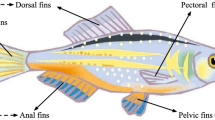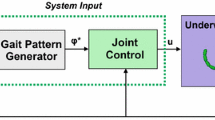Abstract
Underwater robot is a new research field which is emerging quickly in recent years. Previous researches in this field focus on Remotely Operated Vehicles (ROVs), Autonomous Underwater Vehicles (AUVs), underwater manipulators, etc. Fish robot, which is a new type of underwater biomimetic robot, has attracted great attention because of its silence in moving and energy efficiency compared to conventional propeller-oriented propulsive mechanism.
However, most of researches on fish robots have been carried out via empirical or experimental approaches, not based on dynamic optimality. In this paper, we proposed an analytical optimization approach which can guarantee the maximum propulsive velocity of fish robot in the given parametric conditions. First, a dynamic model of 3-joint (4 links) carangiform fish robot is derived, using which the influences of parameters of input torque functions, such as amplitude, frequency and phase difference, on its velocity are investigated by simulation. Second, the maximum velocity of the fish robot is optimized by combining Genetic Algorithm (GA) and Hill Climbing Algorithm (HCA). GA is used to generate the initial optimal parameters of the input functions of the system. Then, the parameters are optimized again by HCA to ensure that the final set of parameters is the “near” global optimization. Finally, both simulations and primitive experiments are carried out to prove the feasibility of the proposed method.
Similar content being viewed by others
References
Lauder G V, Drucker E G. Morphology and experimental hydrodynamics of fish fin control surfaces. IEEE Journal of Oceanic Engineering, 2004, 29, 556–571.
Lighthill M J. Hydromechanics of aquatic animal propulsion. Annual Review of Fluid Mechanics, 1969, 1, 413–446.
Borazjani I, Sotiropoulos F. Numerical investigation of the hydrodynamics of carangiform swimming in the transitional and inertial flow regimes. Journal of Experimental Biology, 2008, 211, 1541–1558.
Guo J. Target Tracking Using a Biomimetic Underwater Vehicle. [2008-2-1], http://findarticles.com/p/articles/mi_qa5367/is_200802/ai_n25138105/
Low K H, Zhou C L, Yu Z. Gait planning for steady swimming control of biomimetic fish robots. Advance Robotics, 2009, 23, 805–829.
Yan Q, Han Z, Zhang S W, Yang J. Parametric research of experiments on a carangiform robotic fish. Journal of Bionic Engineering, 2008, 2008, 95–101.
Yu J Z, Wang L. Parameter optimization of simplified propulsive model for biomimetic robot fish. Proceeding of the IEEE International Conference on Robotics and Automation, Barcelona, Spain, 2005, 3306–3311.
Seo K, Murray R, Lee J S. Exploring optimal gaits for planar carangiform robot fish locomotion. Proceedings of the 16th IFAC World Congress, Prague, Czech, 2005, Tu-E14-TO/3.
Lighthill M J. Note on the swimming of slender fish. Journal of Fluid Mechanics, 1960, 9, 305–317.
Nakashima M, Ohgishi N, Ono K. A study on the propulsive mechanism of a double jointed fish robot utilizing self-excitation control. JSME International Journal C, 2003, 46, 982–990.
Reeves C R, Rowe J E. Genetic Algorithms: Principles and Perspectives, A Guide to GA Theory, Kluwer Academic Publishers, Boston, USA, 2003.
Randy L H, Sue E H. Practical Genetic Algorithms, 2nd edition, John Willey & Son Inc, New York, USA, 2004.
Moore A W. Iterative Improvement Search Hill Climbing, Simulated Annealing, WALKSAT, and Genetic Algorithms, [2009-11-12], http://www.autonlab.org/tutorials/hillclimb.html
Hagiwara M. Pseudo-Hill climbing genetic algorithm (PHGA) for function optimization. Proceedings of the International Joint Conference on Neural Networks, 1993, 1, 713–716.
Houck C R, Joines J A, Kay M G. A Genetic Algorithm for Function Optimization: A Matlab Implementation. Technical Report, Industrial and Systems Engineering, North Carolina State University, 1995.
Author information
Authors and Affiliations
Corresponding author
Rights and permissions
About this article
Cite this article
Vo, T.Q., Kim, H.S. & Lee, B.R. Propulsive Velocity Optimization of 3-Joint Fish Robot Using Genetic-Hill Climbing Algorithm. J Bionic Eng 6, 415–429 (2009). https://doi.org/10.1016/S1672-6529(08)60140-7
Published:
Issue Date:
DOI: https://doi.org/10.1016/S1672-6529(08)60140-7




